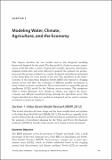Modeling Water, Climate, Agriculture, and the Economy
Author(s)
Yu, Winston; Yang, Yi-Chen; Savitsky, Andre; Alford, Donald; Brown, Casey; Wescoat, James; Debowicz, Dario; Robinson, Sherman; ... Show more Show less
DownloadWescoat_Modeling water.pdf (1.508Mb)
PUBLISHER_CC
Publisher with Creative Commons License
Creative Commons Attribution
Terms of use
Metadata
Show full item recordAbstract
Describes two models used in the integrated modeling framework designed to study water, climate, agriculture and the economy in Pakistan's Indus Basin: (1) the Indus Basin Model Revised (IBMR-1012), a hydro-economic optimization model that takes a variety of inputs (such as agronomic information, irrigation system data, and water inflows) to generate the optimal crop production across the provinces (subject to a variety of physical and political constraints) for every month of the year; and (2) the Computable General Equilibrium Model, which includes 49 economic activities and 48 commodities—plus the quantities and prices of agricultural inputs and agricultural industries beyond crop production—and differentiates across 19 types of households by farm size, tenancy, and poverty level to give detailed insights into social impacts. The IBMR and CGE models have not been jointly used to date, and interesting analytical challenges arise in linking them, but potential linkages could prove beneficial.
Date issued
2013-04Department
Massachusetts Institute of Technology. Department of ArchitectureJournal
The Indus Basin of Pakistan: The Impacts of Climate Risks on Water and Agriculture
Publisher
The World Bank
Citation
Yu, Winston, Yi-Chen Yang, Andre Savitsky, Donald Alford, Casey Brown, James Wescoat, Dario Debowicz, and Sherman Robinson. “Modeling Water, Climate, Agriculture, and the Economy.” The Impacts of Climate Risks on Water and Agriculture (April 18, 2013): 95–118. © International Bank for Reconstruction and Development/The World Bank
Version: Final published version
ISBN
978-0-8213-9874-6
978-0-8213-9875-3